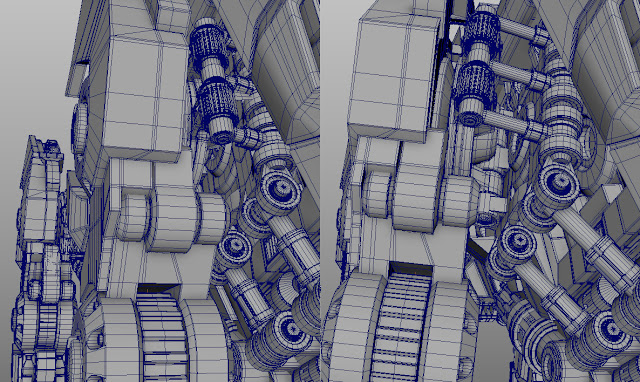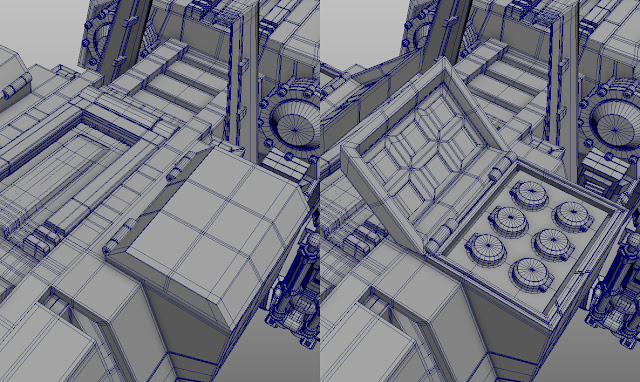Articulation
With the panther fully rigged, I thought it would be a good time to highlight some of the articulation in the model. With a background in engineering, I spent a lot of time thinking about mechanisms that looked cool, had some resemblance to real-world design, while also fitting into the structural hierarchy expected of an animal. Here are some close-ups:
Rather than a ball-joint for the shoulders and hips, I've gone with a three-axis hinge system. X, Y and Z rotations are separately accomplished through these nested plates. I went with this over a simple ball and socket because I felt it looked stronger; mechanical balls always look like they're ready to fall out of the socket. Also, it kind of becomes a scapula (look it up) which ties nicely into mechanical animal 'biology'.
The panther looks pretty intimidating when roaring. It's even got an articulated tongue. The ears flatten just like a real cat, too.
The booster assembly is usually covered when not in use. The stabilising fin also folds in to take up less space. The whole thing can actually retract down closer to the body (not pictured).
Speaking of stabiliser fins, an additional pair are also mounted to the waist. These fold down when the booster is firing to help keep the Zoid on the ground at high speeds.
The foot is a very complex assembly. Each of the toes has three joints and multiple degrees of freedom so they can splay out. The ankle is a ball joint here in contrast to the shoulder, as the freedom of movement is more important and there is limited space. Notice also the "dampers" - the two pistons on the rear of the leg that act as shock absorbers.
Weapons! In addition to teeth, claws, small vulcan cannons in the nose, blasters in the boosters, twin guns on the tip of the tail and the incredibly powerful CPC, there are also a pair of missile pods on the abdomen of the panther. These can be used for both offence and defence, as they can intercept larger incoming missiles. Also pictured top-right are the two cylindrical shield generators, which can project an electromagnetic bubble around the Zoid and - if overloaded - around a neighbouring ally or two as well.
Here we have the ray panels deploying. They open up during charging of the CPC to prevent the Zoid from overheating. Once the CPC has fired, the flaps stay open to allow the remaining excess heat to escape, normally in the form of huge billows of steam.
And finally, the cockpit. Surprisingly cramped! Sat square between the eyes, the pilot has an excellent field of view, supplemented by a HUD with various sensory data picked up by the panther. The controls should be thought of as more like reins than a steering wheel. Zoids are somewhat alive, taking care of the complexities of running and jumping. Much like a horse, the pilot just points them in the right direction.









Hey man.
ReplyDeleteI don't know if you're still updating this, but it looks very well done! I really love the detail work you have put into the actual zoid. I am remaking the Liger Zero Jager myself. I have to say I have taken a lot of inspiration from seeing your work, though I am no engineer so Jager is quite as detailed as your Panther. But I have to say I am in awe of it!